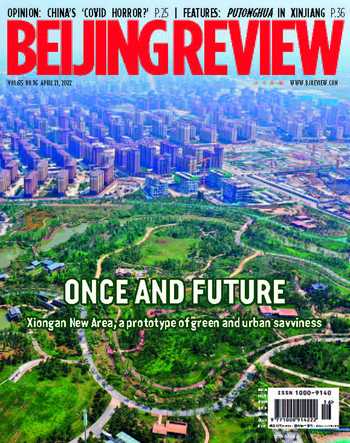A NEW TAKE ON URBANIZATION
2022-04-21ByYinZhi
By Yin Zhi
W hen China announced its decision to establish Xiongan New Area five years ago, it intended to build a green and livable city, catering to residents’ needs, offering quality public services and infrastructure, and creating a new urban management model. It is also planned for the area to relieve Beijing of functions nonessential to its role as the national capital.
Currently, Beijing has overall development advantages than neighboring Tianjin Municipality and Hebei Province. Economic and human resources in the broader region are excessively concentrated in the megacity, leading to its main urban center undertaking too many functions within a limited area.
Therefore, the construction of a satellite city is necessary not only to meet regional development needs, but also to tackle urbanization woes in Beijing, such as overcrowding, traffic congestion and excessively high housing prices. This is the rationale for developing Xiongan, which covers three counties in Hebei and lies about 100 km southwest of Beijing.
From the perspective of urban planning, a satellite city can play two possible roles. First, if its public service, infrastructure and overall environment become better than those of the already overcrowded core city, it can attract population and resources from the latter. Second, it can serve as an alternative destination for people and capital bound for the core city.
Xiongan is expected to play the second role in the foreseeable future, sharing the development momentum brought on by Beijing. There is still a long way to go before it will lure people and resources away from the capital. Whether it can achieve this will depend on how Xiongan improves itself and how the socioeconomic landscape in the Beijing-Tianjin-Hebei region evolves.
At this moment, the transfer of population, industries and services to Xiongan mainly relies on top-down approaches rather than market forces. For this reason, the new area should focus on its role of supporting Beijing while preparing itself for a more important part in advancing coordinated development of Beijing, Tianjin and Hebei as a whole.
In the past five years, efforts have been made in infrastructure improvement, the resettlement of people relocated by ongoing construction projects, and the ecological conservation program for Baiyangdian, the largest freshwater lake in north China. However, its development as a future-oriented functional area has not yet entered the substantive implementation stage.
A large number of plans and technical standards have been compiled. However, it is still too early to draw conclusions on whether they can achieve the expected results.
Two highlights in Xiongan’s development stand out. Zangang is a large suburban cluster of Xiongan where its state-of-the-art high-speed railway station is located. The 91-km intercity line can take passengers from Beijing West Railway Station to Xiongan Railway Station in about 50 minutes. The district has begun to develop itself as a science and technology park, making use of its convenient transportation. The market-led development is in full swing, and many companies have settled there.
The other is the rapid progress of Baiyangdian’s ecological restoration. The implementation of a series of flood control and water resource protection projects will help create a better environment for the future development of Xiongan.
Attracting talent is a big challenge for Xiongan. Past decades of urban development experience in China have shown that the attractiveness of new cities lies in their ability to meet residents’ constantly updating and upgrading pursuits of higher living standards.
Previously, a new area usually attracted industry through policy support, which in turn led to population growth. Recently, however, with China’s reform and openingup program unfolding across the board, the policy gap between regions has narrowed. As a result, urban amenities have become a large drawcard.
In the future, social governance effectiveness and environmental quality are also likely to top the list of considerations for incoming talent.
With Xiongan’s development process moving ahead, more development opportunities will arise in this futuristic city.

First, it will offer a favorable business environment to incoming industries. The operating costs for Xiongan enterprises will not be higher than those in Beijing. A streamlined administrative system will also increase the area’s appeal.
Second, it will feature high-standard public service facilities and put in place an efficient city management system. These in turn will influence the volume and quality of economic and cultural activities in a given area and the types of professionals willing to move there.
Finally, as many people attach evergreater value to living in a healthy environment, Xiongan’s achievements in improving environmental quality will make it more attractive.
China’s urbanization process has entered a time of regional synergy. The role of cities in driving growth still needs to be strengthened. As a country with a large population, larger and more prosperous urbanized areas are crucial to China’s socioeconomic development.
Yet, an urbanization pattern centering on a few megacities is not sustainable. It is necessary to enable the functions that were previously overly concentrated in main cities to now be spread out across a wider area. With the main city at the core, the division and specialization of functions will fuel development in its immediate vicinity as well as in smaller neighboring cities. Additionally, it is imperative to advance urban-rural integration to ensure the parallel development of both.
This is neither a simple process of “deruralization,” nor a process of unregulated urban expansion.
As the government promotes equitable access to public services, the free flow of population and industry between main cities and their surrounding small and mediumsized cities, and even small towns and rural areas, will be made possible. People will then be able to more freely choose their place of residence. BR
